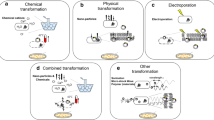Abstract
Recombineering is a homologous-based DNA cloning and modification technique. Recombineering-mediated chromosomal gene knock-in usually involves a selectable/counterselectable cassette. Though a variety of selectable/counterselectable cassettes were developed; however, a specifically designed gene deletion strain or minimal medium is often required. Herein, we describe a novel selectable/counterselectable cassette Plac-ccdB-aacC1 in which aacC1 (gentamicin resistance gene) is used as the selectable marker for the homologous arm-flanked cassette knock-in, while the IPTG inducible ccdB gene is used as the counterselectable marker for chromosomal gene knock-in. The counterselection is achieved via supplementing 1 mM IPTG in the LB agar medium. An oligonucleotide designed to evade the mismatch repair system was utilized to engineer an Escherichia coli DH10B-derived gyrA462 strain that was used to as the host for the plasmid harboring the Plac-ccdB-aacC1 cassette. By using the Plac-ccdB-aacC1 cassette, a linear–linear homologous recombination (LLHR) system was generated by knocking a 6.2 kb araC-PBAD-redγ-recET-recA DNA fragment into the E. coli DH10B chromosome. The functional of the LLHR recombineering system was characterized by cloning of the target DNA from PCR product as well as from the genomic DNA mixture. The Plac-ccdB-aacC1 cassette will be a useful tool in E. coli recombineering.


Similar content being viewed by others
References
Bernard P, Couturier M (1992) Cell killing by the F plasmid CcdB protein involves poisoning of DNA-topoisomerase II complexes. J Mol Biol 226:735–745
Cronan JE (2006) A family of arabinose-inducible Escherichia coli expression vectors having pBR322 copy control. Plasmid 55:152–157
Datsenko KA, Wanner BL (2000) One-step inactivation of chromosomal genes in Escherichia coli K-12 using PCR products. Proc Natl Acad Sci USA 97:6640–6645
DeVito JA (2008) Recombineering with tolC as a selectable/counter-selectable marker: remodeling the rRNA operons of Escherichia coli. Nucleic Acids Res 36:e4
Fu J, Bian X, Hu S, Wang H, Huang F, Seibert PM, Plaza A, Xia L, Muller R, Stewart AF, Zhang Y (2012) Full-length RecE enhances linear–linear homologous recombination and facilitates direct cloning for bioprospecting. Nat Biotechnol 30:440–446
House BL, Mortimer MW, Kahn ML (2004) New recombination methods for Sinorhizobium meliloti genetics. Appl Environ Microbiol 70:2806–2815
Li MZ, Elledge SJ (2005) MAGIC, an in vivo genetic method for the rapid construction of recombinant DNA molecules. Nat Genet 37:311–319
Li XT, Thomason LC, Sawitzke JA, Costantino N, Court DL (2013) Positive and negative selection using the tetA-sacB cassette: recombineering and P1 transduction in Escherichia coli. Nucleic Acids Res 41:e204
Murphy KC (1998) Use of bacteriophage lambda recombination functions to promote gene replacement in Escherichia coli. J Bacteriol 180:2063–2071
Murphy KC (2016) λ Recombination and recombineering. EcoSal Plus. doi:10.1128/ecosalplus.ESP-0011-2015
Sawitzke JA, Costantino N, Li XT, Thomason LC, Bubunenko M, Court C, Court DL (2011) Probing cellular processes with oligo-mediated recombination and using the knowledge gained to optimize recombineering. J Mol Biol 407:45–59
Song J, Dong H, Ma C, Zhao B, Shang G (2010) Construction and functional characterization of an integrative form λ Red recombineering Escherichia coli strain. FEMS Microbiol Lett 309:178–183
Wang H, Bian X, Xia L, Ding X, Muller R, Zhang Y, Fu J, Stewart AF (2014) Improved seamless mutagenesis by recombineering using ccdB for counterselection. Nucleic Acids Res 42:e37
Wang S, Zhao Y, Leiby M, Zhu J (2009) A new positive/negative selection scheme for precise BAC recombineering. Mol Biotechnol 42:110–116
Warming S, Costantino N, Court DL, Jenkins NA, Copeland NG (2005) Simple and highly efficient BAC recombineering using galK selection. Nucleic Acids Res 33:e36
Wong QN, Ng VC, Lin MC, Kung HF, Chan D, Huang JD (2005) Efficient and seamless DNA recombineering using a thymidylate synthase A selection system in Escherichia coli. Nucleic Acids Res 33:e59
Zhang Y, Buchholz F, Muyrers JP, Stewart AF (1998) A new logic for DNA engineering using recombination in Escherichia coli. Nat Genet 20:123–128
Acknowledgements
We than Dr. John Cronan, Dr. Stephen Ellege and Dr. Micheal Khan for kindly providing the strains and plasmids used in this research. Funding was provided by National Natural Science Foundation of China (81273412).
Author information
Authors and Affiliations
Corresponding author
Ethics declarations
Conflict of interest
The authors declare that they have no conflict of interest.
Electronic supplementary material
Below is the link to the electronic supplementary material.
Rights and permissions
About this article
Cite this article
Zhang, Q., Yan, Z., Xu, Y. et al. Characterization of Inducible ccdB Gene as a Counterselectable Marker in Escherichia coli Recombineering. Curr Microbiol 74, 961–964 (2017). https://doi.org/10.1007/s00284-017-1273-3
Received:
Accepted:
Published:
Issue Date:
DOI: https://doi.org/10.1007/s00284-017-1273-3




